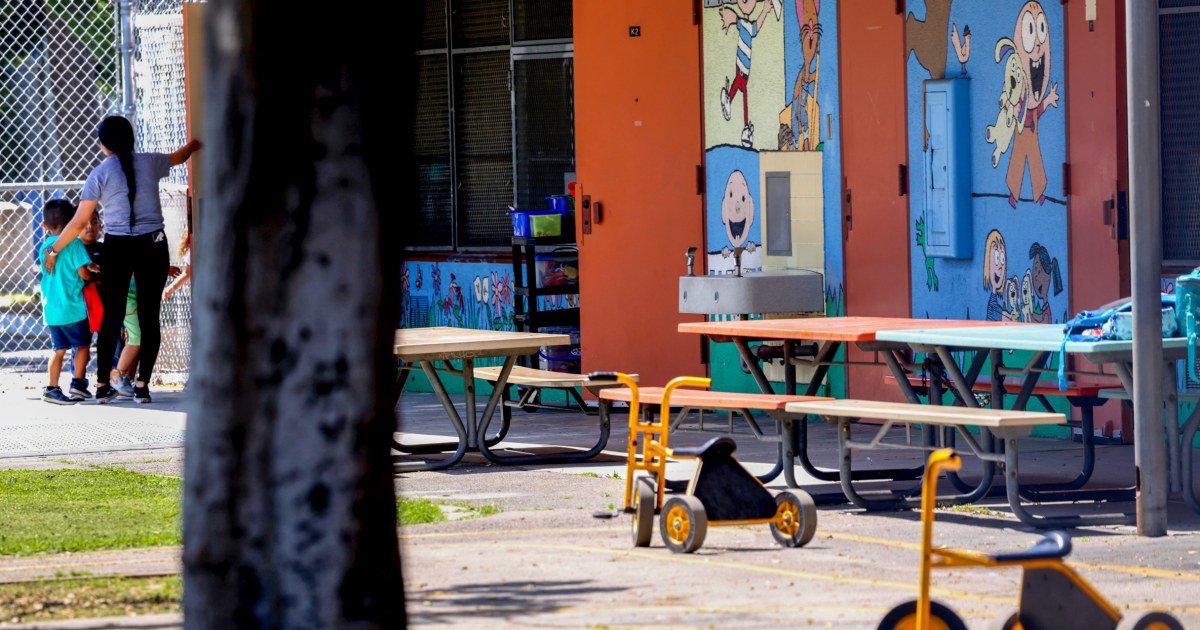As the new school year approaches, the typical concerns of obtaining supplies and organization schedules are aggravated for mixed immigration status families: ask whether or not to send their children to class due to fear of an immigration raid in school.
“I have listened to so many people to ask what to do, whether to take them or not, due to all these fears,” said Oreana, mother of four children enrolled in Phoenix, Arizona schools, Telemundo news.
The fact that places like churches and schools are no longer considered “sensitive” spaces of immigration application actions “causes a lot of fear,” said the Venezuelan woman.
Until the end of January, when President Donald Trump assumed the position, the customs immigration and compliance operations had been restricted in churches, schools and hospitals.
The Trump administration has defended its decision to allow immigration raids in previously delicate places, such as schools. “ICE generally does not carry out immigration application activities in schools or school buses,” the agency told NBC News in March, adding that an immigration action near a school would be of a “case determination by case by case.”
But the fear of possible immigration raids in schools not only came from parents. Last weekend, the Los Angeles Teachers Union maintained a protest to demand that the district make more to protect students from immigrant families.
Last semester, the restlessness after the immigration raids turned out that more students were missing the school, according to Thomas S. Dee, a specialist at the Stanford University School of Education.
Dee published an analysis in June whose results indicate that “recent raids agreed with a 22 percent increase in the daily absences of students” in the Central Valley of California, an agricultural area that houses many immigrant agricultural workers.
School absences were especially notable among preschool and primary students, he said, an age in which parents are more likely to take them to school.
“We saw, when the raids began, a strong increase in the absences of the students that was very distinctive of the typical patterns we would see during the school year,” Dee said in an interview with Telemundo News, and in particular in relation to the baselines we had seen in previous years. “
What the numbers show
Beyond California, states such as Washington State and Illinois have seen similar situations in some school districts.
In Seattle suburbs, the impact is known in the Highline district, which operates almost 30 schools. There, the data show that chronic absenteeism, which lacked more than 10% of a class period, increased to 48% for the school year that ended in July, investing the profits that the district had achieved during the previous two years to reduce the absence rates of K-12.
In Chicago, high school educators also reported a 20% lower assistance compared to the previous year.
But Hispanic K-12 students would probably accumulate more absences before Trump’s second mandate. Some factors include going to work at an earlier age to support the family, health -related reasons or have to take care of a family member during school hours.
In Illinois, Hispanic students had the second highest chronic absenteeism during 2024, with 33%, compared to 26% in all demographic groups, according to data from the State Education Board. Telemundo News contacted the Board and the districts of Illinois to obtain updated data until June 2025, but did not receive an answer.
The current situation adds to schooling interruptions that have been carried out since the COVID-19 pandemic, which resulted in generalized academic delays.
“We are in an environment in which we have seen historical losses in student performance, sustained increases in chronic absenteeism, as well as a remarkable increase in the mental health challenges that young people face,” Dee said. “And so I see that these immigration raids only add to the already considerable challenges of academic recovery that schools currently face.”
Less resources, more anxiety
Being absent several times during a school year has a considerable impact on the education of a student.
“Such extensive absences lead not only to low academic performance; they often lead to students abandoning school. And the impact of abandoning high school is deep,” said the National Association of Directors of Secondary Schools (NASSP) by email.
The association stressed that the profits for those who do not graduate from high school are considerably lower than for those who do it.
The impact, according to experts, goes beyond the classroom.
“Attending school regularly is one of the most powerful predictors of health, well -being and long -term success,” said Josh Sharfstein, of the Johns Hopkins School of Medicine and director of the American Health Initiative of Bloomberg, at a conference in mid -June.
This is because absences can affect the emotional and intellectual development of children, as well as their education. For example, they can trigger anxiety disorders that further damage the well -being of children and further encourage school absences.
Several associations have launched a campaign that asks school absences to be considered a public health problem.
“When several students in a classroom are chronically absent, the rotation in the classroom affects everyone, including colleagues who had good assistance. It makes it more difficult for teachers to teach and establish the classroom standards, as well as that students connect with each other,” said Hedy Chang, executive director of the group of assistance works, leading a campaign launched in June.
Chronic absenteeism due to the fear of immigration raids can have an economic effect, according to Dee.
“This also has financial implications for school districts,” he said. California is one of the few states that the bases help, in part, in the average daily assistance, according to Dee, so at least children show, that means less resources.
“I would expect it to have pejorative economic consequences for these communities, as well as for the financial viability of the school districts that served them,” Dee said.
In many districts, repeated crimes related to absenteeism can also lead to young people to be sent to the court of absenteeism. There, the sanctions can vary from paying fines to time in youth detention.
Latin, black and indigenous young people in the United States already refer more frequently to the absenteeism court than non -Hispanic white students, partly because the absences of old demographic groups are more likely to be registered as “unjustified or unjustified,” shows the investigation.
Preventive strategies
In response to long -standing concerns about absenteeism, there are strategies to combat absenteeism.
“There are many steps that the districts, schools, families and community partners can take to improve assistance,” said Chang, of assistance.
In a Connecticut school where assistance fell at the beginning of the year due to the fear of immigration raids, absenteeism was successfully stopped towards the end of the semester with measures such as contacting families directly and developing contingency plans.
These strategies include reaching community leaders, such as local church figures or food bank workers, who have contact with certain families to help them encourage them to continue sending their children to school.
Another strategy that according to the directors of the school belonging to NASSP have helped is to maintain close contact with the students, for example, to call the homes of their families to verify them.
Experts expect these types of measures to help address the problem of absences in mixed immigration status students who fear possible immigration.
“In some districts, we have heard of students who cannot attend classes regularly at this time for reasons such as the fear of raids, and they have been offered virtual learning,” Dee said. “I think that educators must be more aware of the challenges that their students currently face due to these problems.”
For now, with protests such as the one that the Teacher Union celebrated in Los Angeles, additional options are being explored, such as a campaign throughout the district to educate parents about the importance of sharing an emergency contact with school administrators in case a father is deported while the child is in school.
In the Highline school district in the state of Washington, communications manager Tove Tupper said in an email that they are “committed to protecting the rights and dignity of all students, families and personnel” and ensuring that all students “have the right to public education, as protected by law”, regardless of citizenship or immigration state.
An earlier version of this story was first published in Telemundo News.









